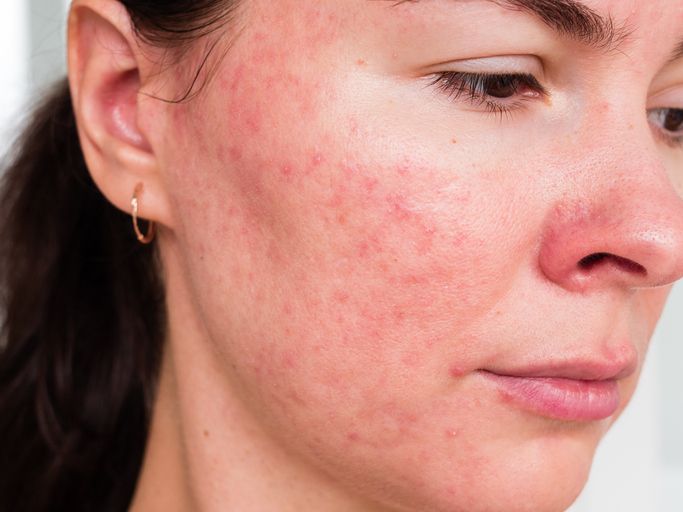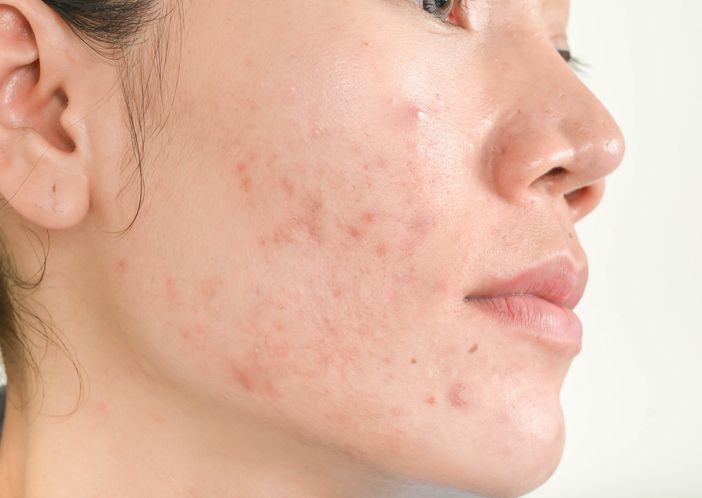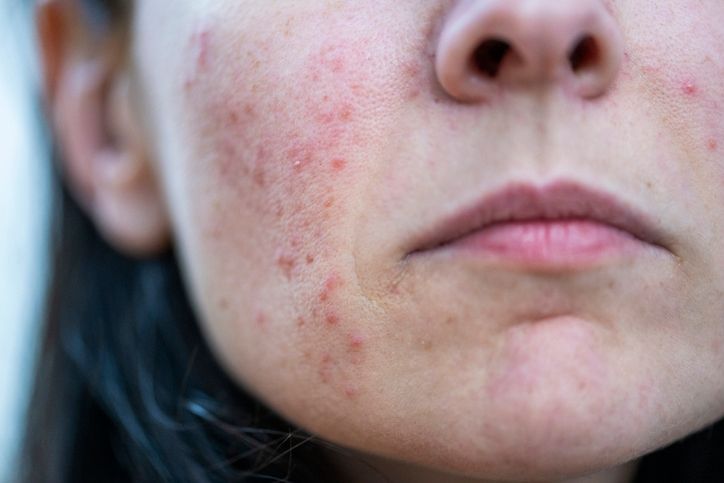Author: Natalie Ng|Updated: 30 April 2025
If your skin’s been feeling extra oily or dry, flaring up with random breakouts, or just acting weird with redness and flakiness—it might be a sign your skin’s pH is off. These things don’t always mean there’s a pH problem, but they’re signals your skin’s trying to tell you something. Your skin has a natural pH level that helps protect it from irritation, dryness, and bacteria. When that balance gets thrown off—whether from harsh cleansers, hot showers, tap water, or just everyday life—it can mess with how your skin looks and feels. A healthy skin barrier needs a slightly acidic pH to stay strong, and when that shifts too much, you’ll probably notice. In this article, we’ll break down what pH actually means for your skin, why it matters, and how to tell if something’s off. Stick around to learn what to look out for—and what you can do about it.

Excessive Oiliness or Dryness

Your skin might feel greasy all day or tight and flaky for no clear reason. While this doesn’t always mean your skin’s pH is off, it can be one of the signs that your skin barrier isn’t happy.
Oiliness Might Mean Dehydration
If your skin is producing too much oil, it could be reacting to dryness underneath. When the skin’s surface loses moisture, it sometimes boosts sebum production to make up for it. This can leave your face looking shiny, even if it feels dry underneath. A disrupted skin's pH balance might make this worse, especially if you're using harsh facial cleansers or alkaline soaps that strip your natural skin surface oils.
Dryness Could Be a Sign of Damage
Dry patches or tightness might mean your skin barrier has been weakened. That can happen when your skin care routine includes products that are too drying or have the wrong pH. Most skin care products should support your skin’s natural pH, which is slightly acidic. If you’re using things with a higher pH—or if your tap water is very alkaline—it might disturb your acid mantle, the thin layer that helps protect the outermost layer of your skin.
Solutions
• Use gentle cleansers with a neutral pH or ones labeled pH-balanced
• Avoid alkaline products that can disrupt your skin's pH level
• Pay attention to how your skin reacts after cleansing—tightness often means the product is too harsh
• Keep your routine simple and consistent

Persistent Redness and Irritation

If your skin stays red or feels irritated often, it might be reacting to more than just a pH issue. Redness and sensitivity can happen for a lot of reasons—product reactions, weather changes, allergies, or naturally sensitive skin types.
Not Always a pH Problem
Redness doesn’t automatically mean your skin’s pH is off. You might be reacting to something in your routine or the environment. Fragrance, alcohol in products, or even temperature changes can all cause inflammation on the skin surface, especially if your skin is already sensitive.
But if redness shows up with other signs—like burning, stinging, or increased dryness—it could mean your skin's acid mantle is damaged. That’s the protective layer on the outermost part of your skin that helps keep moisture in and irritants out. A disrupted skin’s pH level can weaken this barrier, making your skin more reactive.
How to Spot pH-Related Redness
Some signs that redness might be linked to your skin’s pH balance:
• The irritation gets worse after cleansing
• You feel a stinging or burning sensation after applying basic products
• Redness becomes more intense with repeated product use, even mild ones
These could suggest your products are either too alkaline or too acidic for your skin’s natural pH. Over time, that can lower your skin’s defenses and increase inflammation.
Solutions
• Use skincare products with a pH that supports your skin’s natural slightly acidic level
• Avoid over-exfoliating, especially with acids or physical scrubs
• Choose a skin toner that helps maintain skin pH and reduce inflammation
• Simplify your skin care routine while your skin calms down—fewer ingredients means less risk of irritation
If the redness continues or gets worse, it’s a good idea to talk to a dermatologist. They can help find out whether it’s caused by pH changes or another skin condition.
Book Now to Experience
Acne Treatment
1 Minute Self-Registration
Date should not be before minimal date

Breakouts and Acne Flare-Ups

If you’re suddenly dealing with more breakouts or acne in places you don’t usually get them, it could be a sign your skin’s pH is off. While acne can happen for many reasons—like hormones or clogged pores—changes in your skin's pH level can make things worse.
How pH Affects Breakouts
Your skin has a natural slightly acidic pH that keeps your barrier strong and helps prevent bacteria from spreading. When that balance shifts, especially toward a more alkaline pH, it creates a weak barrier. That makes it easier for acne-causing bacteria to grow and for your skin to become inflamed.
If you’ve recently changed products or overused exfoliants, you might notice breakouts that feel different from your usual acne—more widespread, irritated, or popping up in new areas. That could be your skin reacting to something that’s throwing off your skin’s acid mantle.
Solutions
• Use facial cleansers and skincare products that are pH-balanced to match your skin’s natural pH
• Avoid using products that are too acidic or considered alkaline
• Look for ingredients that support a balanced skin pH, like ascorbic acid (vitamin C) in low concentrations
• Don’t overload your routine—stick to gentle steps that maintain your skin barrier
• If using active ingredients like retinoids or exfoliating acids, space them out to avoid overwhelming your skin
Keeping your skin’s pH in a healthy range supports better barrier function and can help reduce breakouts over time—especially if your acne is linked to product use or external factors.

Tight, Itchy, or Flaky Patches

If your skin feels tight, itchy, or starts flaking for no clear reason, it could mean your skin’s pH is out of balance. These symptoms often show up when your skin barrier isn’t working well and can’t hold on to moisture properly.
Why This Happens
Your skin's natural surface is slightly acidic, which helps form a protective barrier. This barrier, called the acid mantle, locks in moisture and shields your skin from outside irritants. When the pH shifts—especially toward an alkaline range—it can strip away your natural oils. That leaves the outermost layer of skin dry, exposed, and uncomfortable.
Harsh facial cleansers, over-exfoliating, or using products that don’t match your skin type can all raise your skin’s pH. Even pure water, which has a neutral pH, can temporarily affect the skin surface if used too often without follow-up hydration.
Solutions
• Choose gentle cleansers and skin care products that support your skin’s mildly acidic pH
• Avoid anything labeled as soap or products considered alkaline
• Add a hydrating toner or moisturizer to help restore moisture and support barrier function
• Use products with soothing ingredients if your skin is itchy, but avoid anything too active or scented
• Protect your skin from cold or dry air, which can make flakiness worse
Restoring a balanced skin pH helps repair the skin barrier, reduce irritation, and prevent moisture loss—key steps to keeping your skin healthy and comfortable.

How Acne Treatment Can Help Restore Your Skin’s pH Balance
If your skin’s pH level is off and you're dealing with constant breakouts, irritation, or oil imbalance, finding the right treatment can make a real difference. One option that supports skin healing and helps bring your pH back to a healthy range is a non-invasive Acne Treatment designed specifically for acne-prone and sensitive skin.
What It Does
The treatment starts by exfoliating dead skin cells and unclogging pores using dual spiral suction and drainage technology. This step deeply cleans the skin surface, removing excess sebum and buildup that may be triggering breakouts and disrupting your skin's natural pH.
Once the skin is cleared, a hydrating serum is infused into the deeper layers of the skin. This serum helps restore moisture levels, calm the sebaceous glands, and rebalance oil production. Supporting the skin barrier in this way helps your skin return to its natural skin surface pH, which is slightly acidic—ideal for healthy skin.
Why It Works for pH Imbalance
A balanced skin pH is essential for maintaining your skin’s protective barrier. If the pH shifts too far—whether due to harsh products, alkaline soaps, or internal and external factors—your skin becomes more prone to acne, redness, and flaking. This treatment helps by clearing away impurities that affect skin pH while hydrating and supporting the acid mantle.
Advantages of This Treatment
• Non-invasive: No needles, downtime, or medication needed
• Targets multiple issues: Works on acne, blackheads, whiteheads, dullness, and acne scars
• Supports pH recovery: Clears blocked pores without stripping the skin’s natural oils
• Suitable for most skin types, including sensitive skin
• Promotes clearer, more balanced skin with reduced oiliness and fewer breakouts
How It Helps You Maintain Healthy Skin
By regularly removing buildup and supporting hydration, this treatment helps maintain a balanced skin pH, improves your barrier function, and keeps acne-causing bacteria in check. Over time, this supports clearer, smoother skin that’s better protected against both dryness and excess oil.
Want to try it yourself? Book your Acne Treatment session now and start restoring your skin’s natural balance—one step closer to healthy, clear skin.
New Beauty's Acne TreatmentBook Now to Experience
Acne Treatment
1 Minute Self-Registration
Date should not be before minimal date
FAQ
How Often Should I Test My Skin's Ph Level at Home?
You don't need to test your skin's pH frequently - once every few weeks is sufficient unless you're experiencing issues. When you notice changes in your skin's texture, oiliness, or sensitivity, that's a good time to check. Use pH testing strips designed for skin, and test in the morning before applying any products. Remember to test multiple areas, as pH levels can vary across your face and body.
Can Medications Affect My Skin's Natural Ph Balance?
Your medications can definitely impact your skin's pH balance. Antibiotics, hormonal treatments, and certain prescription drugs can disrupt your skin's natural acid mantle. You'll notice changes through dryness, oiliness, or increased sensitivity. If you're on long-term medication, work with your healthcare provider to monitor these effects and adjust your skincare routine accordingly. Consider using pH-balanced products to help maintain equilibrium.
What Role Does Diet Play in Maintaining Healthy Skin Ph?
Your diet directly influences your skin's pH balance through the foods you consume. Eating alkaline-rich foods like leafy greens, fruits, and nuts helps maintain ideal pH levels, while excess sugar, processed foods, and dairy can create acidic conditions. You'll want to boost your intake of omega-3 fatty acids, antioxidants, and vitamin C to support your skin's natural pH-regulating mechanisms. Don't forget to stay hydrated!
Does Tap Water Quality Impact Skin Ph During Washing?
Yes, your tap water quality directly affects your skin's pH when washing. Hard water, containing high mineral content, can disrupt your skin's natural pH balance and create a more alkaline environment. You'll notice this through dryness, irritation, or a tight feeling after washing. Consider installing a water filter or using pH-balanced cleansers to protect your skin's natural barrier while washing.
Are There Specific Ph Levels for Different Areas of the Face?
Your face has distinct pH zones that you'll want to understand. Your T-zone (forehead, nose, chin) typically runs more acidic at 4.5-5.0 due to higher oil production. Your cheeks maintain a slightly higher pH of 5.0-5.4, while the area around your eyes is more delicate with a pH of 5.5-6.0. Knowing these variations helps you choose targeted products for each zone.
Recommended Articles
COPYRIGHT© NEW BEAUTY MANAGEMENT LIMITED 2025. ALL RIGHT RESERVED.




